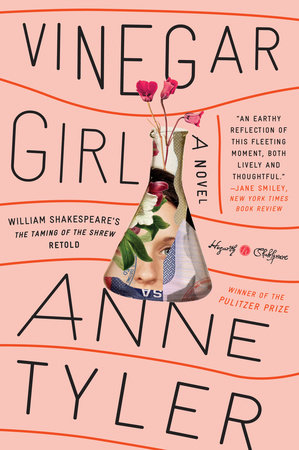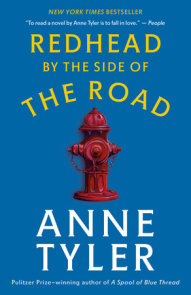Author Q&A
A Conversation with Anne Tyler
Jennifer Morgan Gray is a writer and editor who lives near Washington, D.C.
Jennifer Morgan Gray: Was there a particular character, image, or idea that inspired the writing of Digging to America?
Anne Tyler: In the summer of 1997, I drove my younger daughter to the Baltimore airport to pick up her husband-to-be, who was flying in from San Francisco for our annual beach trip. When we arrived, we found a gigantic, boisterous collection of strangers assembled, holding placards that made it clear they were waiting to welcome a baby. Of course we had to stay and watch what happened. (In fact, that’s the two of us on page four–the mother and grown daughter.) The baby turned out to be a tiny, very serious Korean boy about six or eight months old, and seeing his new parents reach out to take him from the attendant was one of the most moving moments imaginable. It hung on in my mind for several years, germinating in the dark the way seeds for novels often do.
JMG: I’ve actually had an “arrival day” experience myself: When my younger sister arrived from South Korea twenty-two years ago, my entire family gathered at the airport to welcome her (and we watch the video every year). You’ve captured the feeling of the day–anticipation and nervousness and joy–so perfectly. What prompted you to begin the book with this scene? How does the interaction of the two families give a good glimpse of what’s to come?
AT: I wish I could see that video! One of the thoughts that occurred to me while I was watching the family at the airport was that some people seem by nature so exuberant and outgoing and celebratory, larger than life almost. That’s why I came up with the idea of a second family whose style was the polar opposite–I’ve always been fascinated by inborn, dyed-in-the-wool character traits. And it was fun to set up that first scene as a microcosm of the two families’ future interactions.
JMG: The two families in the book are linked because of their experiences with adoption. Did you research adoptive families before reading the book, or did you have any personal experience with adoption?
AT: As with all my books, I relied on idle daydreams rather than research or personal experience. I thought for months and for years about that family I saw in the airport; I wondered how things were going with them; I entertained various “what-ifs” about how it must feel to take on a ready-made son or daughter. In time, I could almost believe I’d been through the experience myself.
JMG: How did you come up with the title Digging to America? What meaning did you hope readers would take from it–both when they lifted the book from the shelf and after they’d finished reading it? How does it reflect Jin-Ho’s question to her grandfather about children digging to America from her sister’s homeland of China?
AT: The title just drifted in on its own; I’m sure we’ve all had that childish notion of digging to the other side of the world. What surprised me in the writing of this book, though, is that my offhand decision to include Iranian characters (the result of many fond memories of my late husband’s gigantic family in Tehran) gradually turned it into a story about a different kind of digging: the immigrant’s attempt to break through the crust of a foreign culture.
JMG: Maryam thinks that her son and daughter-in-law have a crush on the Donaldsons. What about the family is so alluring to Sami and Ziba? How, in turn, do Sami and Ziba intrigue Bitsy and Brad? How does Sami’s “fight” with Brad bring the two families closer together?
AT: To me, the Donaldsons’ and the Yazdans’ relationship is a romance with the “Other.” It’s composed in equal parts of an attraction toward differentness, a concern that the differentness may be betterness, and the subtle resentment that such a concern calls forth. The families love each other, in their varying ways, but it’s a complicated and ambivalent love–as Brad’s and Sami’s half slugfest, half embrace suggests.
JMG: On page 49, Connie says, “Aren’t family gatherings wearing? They think they can just say anything.” How is Connie’s assessment correct, both in describing the workings of the Yazdans and of her own family? How would both families–the Yazdans in particular– benefit from more forthright dialogue?
AT: Dear Connie is just trying to be a comfort. Maryam’s observation is closer to the truth: The Yazdans, who practice the Iranian tradition of elaborate, formal politeness, would be better off exercising a little more bluntness. And that includes Maryam herself: Why didn’t she just say from the start that she didn’t want to host the party?
JMG: On page 111, Dave says of the Yazdans: “On the surface they seemed all primary colors, innocent and impressionable, but he’d had glimpses of more complicated interiors from time to time.” How do you think Maryam would comment on this assessment? Couldn’t Dave’s observation apply to some members of the Donaldson family as well?
AT: Maryam would be delighted by Dave’s statement, if only he knew. It allows the Yazdans the complexity and particularity that she thinks most Americans fail to acknowledge in foreigners.
JMG: While the book is told from many different points of view, Maryam opens and closes the novel. How does she evolve throughout the course of the book? What about her is so “intimidating” to others, and how is her façade a protective armor? Is she really unsocial?
AT: I was more and more drawn to Maryam as I was writing about her. I like her dignity. And while she does become more open and flexible by the end of the book, she remains quite firmly herself– not unsocial so much as reserved. I admired that.
JMG: It’s interesting that as the narrative focus of the book shifts, the reader sees the world through Jin-Ho’s eyes, but not through Susan’s. What made you decide to do this? How does Jin-Ho share Maryam’s feeling of not belonging?
AT: My main concern was not to have too much of either girl’s voice. A little of a child’s-eye view goes a long way, in my opinion– you don’t want to sound “cute,” and you certainly don’t want to force the reader to stay too long in the terrible country of childhood. So I limited my vantage point to just one of the girls, and because of where that fell in the alternating Yazdan/Donaldson chapters, it happened to be Jin-Ho. It could as easily have been Susan. I’ve been surprised, incidentally, by the number of readers who have asked why that chapter refers to “Jin-Ho’s mom” and “Jin-Ho’s dad” instead of “Bitsy” and “Brad,” as they’re called throughout the rest of the book. To me that seems obvious: most children don’t think of their parents by their first names. Certainly Jin-Ho doesn’t, and she’s the one whose head we’re inside in Chapter 9.
JMG: How is Xiu-Mei’s adoption a different experience for the Donaldsons than Jin-Ho’s? Does Bitsy’s attitude about parenting change during that time?
AT: There are clear differences in the Donaldsons’ experience with Xiu-Mei, but I see them as merely circumstantial. Xiu-Mei is physically frailer and therefore more taxing; Bitsy is a few years older and less resilient. And like most parents, Bitsy has lost a bit of her perfectionist zeal by the time her second child arrives.
JMG: You deftly weave issues of culture, class, and wealth throughout the book. Why did you choose to have the Donaldsons keep the Asian names of their children, while the Yazdans changed hers? How does each family feel threatened by the other?
AT: It made sense to me that the Donaldsons–so intent upon political correctness, so determinedly inclusive–would bend over backwards to encourage the foreignness of their child; while the Yazdans’ longing to fit in would lead them to Americanize their own child as much as possible.
JMG: “We all think the others belong more,” Dave tells Maryam on page 181. Would you say that this book is finding a place within the world? Ultimately, who in this book has the greatest chance of being successful in that quest?
AT: Absolutely that’s what this book is about, although I didn’t know that when I began it. (I thought it was about, maybe, the randomness of families.) But because I agree with Dave that we all feel the others belong more, I don’t think a single one of these characters will ever reach the point where he or she would say, “I’ve succeeded; I’m in. I can sit back and breathe easy now.”
JMG: Bitsy feels that Jin-Ho’s arrival is all part of a plan. Do you agree with her philosophy that things happen for a reason? How is her philosophy shaken by events later in the novel?
AT: Oh, well, Bitsy! She’s always going to say that her way is the best way, and so of course that means it’s part of some grand plan. But life has a tendency to wear people’s edges down over time, and I think Bitsy has lost much of her certitude by the end of the book.
JMG: Bitsy and her first husband are thrust together because their families felt they should be soulmates. Do you think Jin-Ho and “bossy Susan” are in danger of the same fate? How are the two girls similar, and how are they different?
AT: That’s an interesting point. I hadn’t thought of the parallel with Bitsy’s first marriage. I imagine that Jin-Ho and Susan will resist their association more and more as they grow older. I can picture the two of them in their teens, sulking in opposite corners of every Arrival Party, listening to totally different styles of music on their headphones and wearing clothes as unlike each other’s as possible. By the time they’re adults, though . . . well, who knows?
JMG: By the end of the book, Maryam realizes that she’s “winnowed out the people she’s not at ease with.” What about Dave makes her feel uneasy, and how does he make her feel comfortable? Do the two really love one another?
AT: In fact, Maryam is no less guilty of pigeonholing than other people are. Much of her uneasiness with Dave is based simply on his being “so American.” But, yes, I believe they love each other. A lot of misunderstandings may await them in the future, but I do think it’s real love.
JMG: Why does Maryam elect to join the Donaldsons when they knock at her door–although it would have been just as easy for her not to?
AT: That’s just one more step in the Immigration Tango–the pull toward assimilation warring with the fear of losing one’s true self.
JMG: Were there any special routines you followed or books you read while writing this book, to inspire creativity? What were they?
AT: By now I know not to expect “inspiration.” It’s more a matter of going into my writing room at the same time every day, sitting in the same chair, and trusting that mere routine will somehow see me through.
JMG: Is there any particular project that you’re working on right now? What can readers look forward to seeing from you next?
AT: I’m at the very faltering beginning of a book about a man who’s decided he has nothing more to expect from his life. But it’s going so badly that the beginning may be as far as it gets.





























